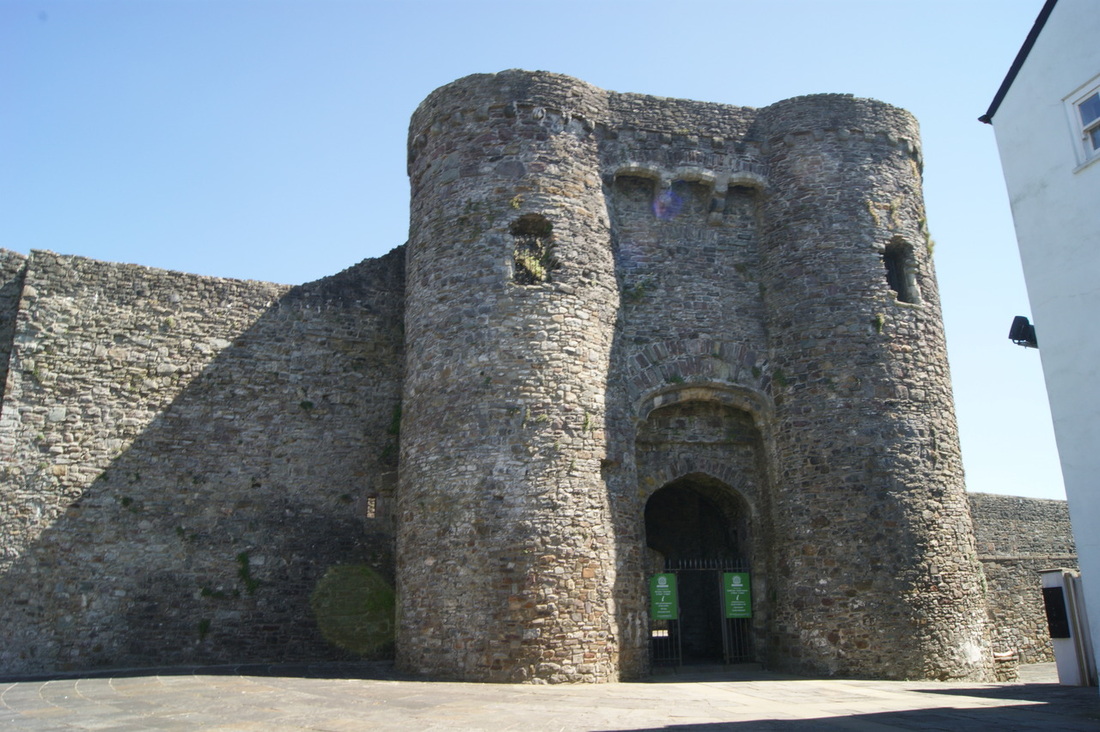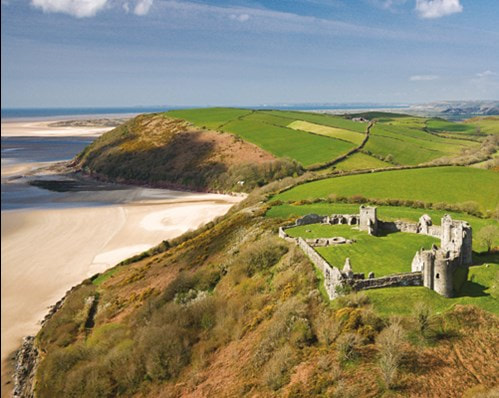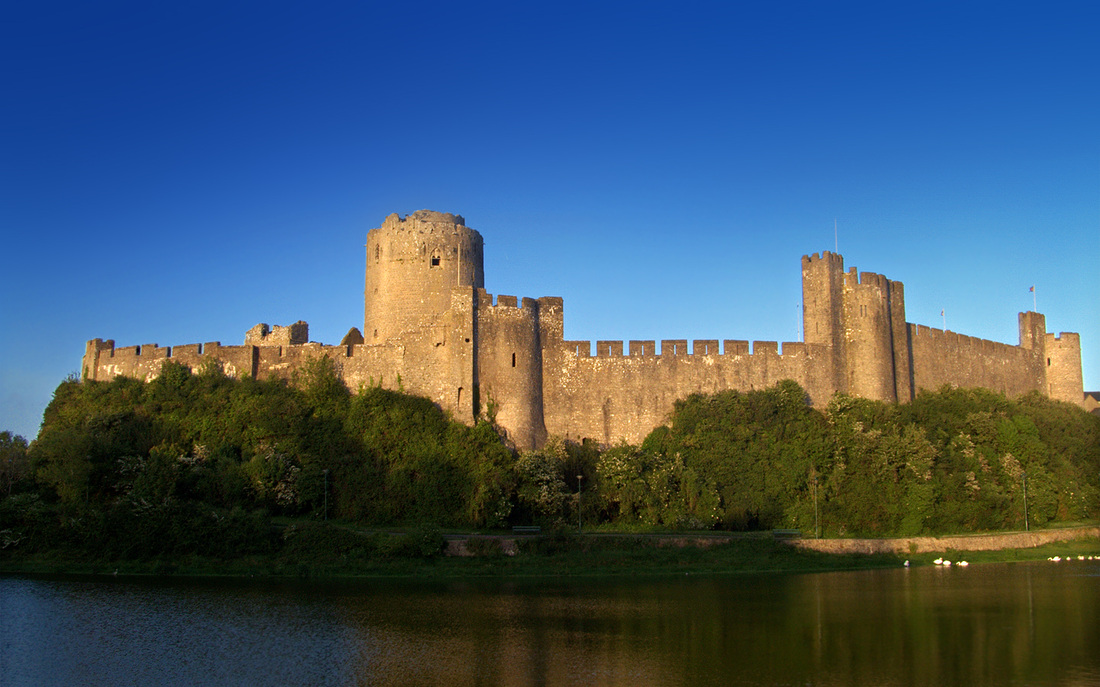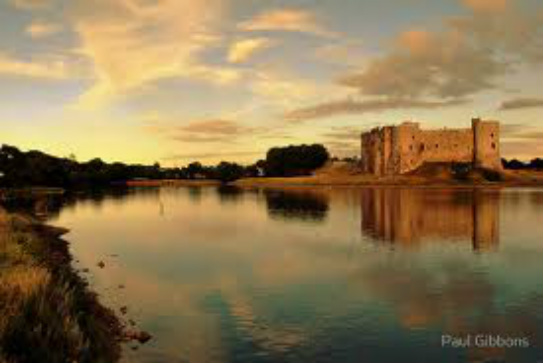Photo above is Laugharne Castle
Did You Know
Wales has more Castles per Head than Anywhere Else in the World
And these are some you will see when you holiday in Wales
Many of these wonderful Welsh Castles are within a short drive of Lothlorien Cottage Accomodation .See Map at Bottom of page.
|
Above and Below Carreg Cennen CastleOne of the most spectacularly sited Welsh castles is Carreg Cennen, a few miles south-east of Llandeilo on a minor road off the A483. Spell-binding views are waiting to be experienced from the sharp hilltop upon which the castle sits. Indeed, Carreg Cennen dominates its surroundings, and seems out of place in the mountainous farming terrain which it commands. The hedgerows along the minor approach road initially obscure views of the site, but suddenly the grey stone fortress springs into your line of sight, enticing you to hurry onwards.
The story of Carreg Cennen Castle is a long one, going back at least to the 13th century. There is archaeological evidence, however, that the Romans and prehistoric peoples occupied the craggy hilltop centuries earlier (a cache of Roman coins and four prehistoric skeletons have been unearthed at the site). Although the Welsh Princes of Deheubarth built the first castle at Carreg Cennen, what remains today dates to King Edward I's momentous period of castle-building in Wales. Dinefwr castle
Landimore Castle
Kidwelly Castle
Dryswyn Castle
Laugharne castle(photo by Paula J James)
Pembroke is noteworthy as the only castle in Britain to be built over a natural cavern, a large cave known as the Wogan. Historically, Pembroke is important not only for its masonry but for the fact the Harri Tudur, who became Henry VII and inaugurated the Tudor line of monarchs, was born there in 1457 reputedly in the tower now known as the Henry VII Tower.
During the troubled reign of King Charles I, the castle was attacked in turn by both Royalist and by Roundheads as the sympathies of its occupants altered. In the latter stages of the struggle an attacking force was led by Cromwell himself. Today, Pembroke Castle is owned and managed by a Private Charitable Trust. Over the past 10 years much effort has been made to bring the history of the castle to life. In this respect the visitor will find an exhibition room telling the fascinating history of the castle from the arrival of Arnulf de Montgomery to the present day, in addition there are a number of exciting tableaux depicting various moments in the castle's history such as the birth of Henry VII. The castle and a well stocked gift shop are open all year. There is a Cafe and a Brass Rubbing Centre open during the summer months and at other times by arrangement. Caerphilly CastleThe largest castle in Wales, and the second-largest in Britain, Caerphilly was locked within water defences when it was built by the English during the 13th century. The outside is the place, among an array of delights, to see four siege engines, and the inside has a hallowed, majestic feel.The Castle is a 60 minute drive from Lothlorien Cottage
Photo Below is Carew Celtic Cross
Carew castle dates from around the 13th century athough before that it was probably of an earth and timber construction dating back to about 1100. but there is also archaeolgical evidence of an earlier settlement dating back 2000 years!
As of most castles, structures have been added and modified over the centuries. Carew was also the scene of the last Great Tournament when in 1507, six hundred noblemen attended the last of it's kind in Britain. Attractions at Carew are not only confined to the castle. There is a restored 18th century tidal mill, with it's original machinery, walks to a 23 acre mill pond,a medieval bridge, and also the 11th century Celtic cross, pictured left is one of the three finest in Wales. Pentre Ifan Burial Chamber
The most popular megalithic site in Wales, Pentre Ifan is a splendid burial chamber with a huge capstone delicately poised on three uprights. Once known as Arthurs' Quoit, Pentre Ifan means Ivan's Village. This monument, dating back to about 3500 BC and unusually oriented north-south, stands on the slopes of a ridge commanding extensive views over the Nevern Valley. The elegant capstone weighs over 16 tons; it is 5m (16ft 6in) long and 2.4m (8ft) off the ground. The stones of the chamber are all of local igneous rock; on the portal stone there is a faint decorative cupmark.
Excavations in 1936-7 and 1958-9 showed that the burial chamber originally lay within a shallow oval pit, and that the trapezoidal mound of earth covering it was up to 36m (120ft) long. The semi-circular façade, as in the Irish court-tombs, was marked by two upright stones on either side of the south-facing portal. The forecourt was blocked with rows of tightly wedged stones; some of the original kerbstones around the barrow can still be seen. Within the cairn were a number of enigmatic features: a slumped stone, deliberately felled before the cairn was built, an irregular line of small stone-holes and a pit with signs of burning. No trace of burials was found here, but we may assume that such a large tomb would have been used for collective burial over many years. The number of artefacts discovered was very small; a recent analysis suggests that Pentre Ifan may be a structure built in two periods: the original portal dolmen tomb could have been later embellished by a cairn and a façade. Local lore says that sometimes fairies are seen here: they are described as 'little children in clothes like soldiers' clothes and with red caps'. Pentre Ifan Burial Chamber is 90 minutes from lothlorien Holiday Cottage in the Pembrokeshire National Park at Newport just outside Fishguard |




















